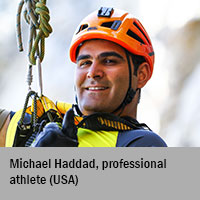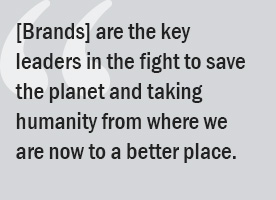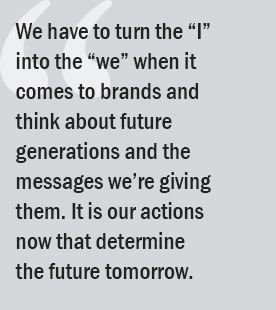Uncategorized
Annual Meeting Keynote Speaker: Defeating Disability, Inspiring Individuals and Brands to Save the Planet
Published: April 1, 2019
 The keynote speaker at INTA’s 2019 Annual Meeting, Michael Haddad, is a professional athlete, the holder of three world records, and an environmental advocate who was named a climate change champion in 2016 by the United Nations Development Programme. His messages of overcoming the impossible and applying sheer determination to transform one’s situation have inspired people all over the world, and now Mr. Haddad, who is paralyzed from the chest down, is on a mission to convince the world that, as he once was, “Earth itself is sitting in a wheelchair” and needs our help to walk again.
The keynote speaker at INTA’s 2019 Annual Meeting, Michael Haddad, is a professional athlete, the holder of three world records, and an environmental advocate who was named a climate change champion in 2016 by the United Nations Development Programme. His messages of overcoming the impossible and applying sheer determination to transform one’s situation have inspired people all over the world, and now Mr. Haddad, who is paralyzed from the chest down, is on a mission to convince the world that, as he once was, “Earth itself is sitting in a wheelchair” and needs our help to walk again.
Mr. Haddad suffered a spinal cord injury stemming from a Jet Ski accident at age six, and it was thought to be a medical impossibility for him to walk again. Yet, he traversed 60,000 steps in the mountains of Lebanon in 2013 to raise awareness about reforestation; climbed the iconic Pigeon Rock in Raouche, Beirut, in 2015 to underscore water pollution and marine life threats; snowshoed the Black Summit, Lebanon’s highest peak, in 2015 to draw attention to climate change; and is presently gearing up for his next challenge at the North Pole.
Mr. Haddad’s athletic achievements have inspired the spinal cord injury research field and, with his participation and collaboration, have led to studies and advancements in exoskeleton technology. Through all of this, he maintains laser sharp focus on what he deems “the number one killer” in the world today: climate change.
The INTA Bulletin connected with Mr. Haddad to gain insight into his background and achievements, what brands can learn from his story, the “baby steps” we can all be taking to combat climate change, and why your personal brand should start with “we.”
What do you think INTA’s audience can learn from your personal story?
There are two important messages I want to convey. The first is the ability of humans to overcome obstacles and do the impossible. I went from being a person who was told I could never walk due to a spinal cord injury at the age of six to setting three world records and prompting medical and scientific research to study the power of the brain and will. The second point I want to make is about how to position success. As a person who could not walk, I chose to use my platform and personal story to illustrate that Earth itself is sitting in a wheelchair, in order to raise awareness for climate change and the planet, but also for future generations. Once we overcome the obstacles and reach success, we have to be careful to position that success responsibly.
 How is Earth “sitting in a wheelchair”?
How is Earth “sitting in a wheelchair”?
Humans are facing a major challenge. We are at a turning point that might ultimately be catastrophic. I have committed to working for the United Nations Vision 2030, which includes 17 sustainable development goals, number 13 being, “Take urgent action to combat climate change and its impacts.” I believe climate change is the number one killer. We are losing our waters and our forests as the result of our actions over the past 200 years. It’s time for us to act or we’re going to pay a very high price.
Can you talk more about the work you’re doing with the United Nations?
One of the next challenges I’m preparing for under the United Nations flag is to walk 100 kilometers (62 miles) at the North Pole to raise awareness about climate change. Putting a person who is paralyzed from the chest down on the North Pole is like putting a person on the Moon-it’s a great scientific challenge! The purpose is to create a communication platform for world influencers. The North Pole is symbolic in that it is a direct indication that climate change is real, due to loss of the Arctic Shelf, and the 100-kilometer goal is a technological challenge that will both inspire others with movement disabilities and help to improve available technologies for those with spinal cord injuries through the advanced research we will be conducting. It’s also a significant study for brain modulation, as far as how the brain works to overcome and endure high performance challenges. The message is very simple: it’s time for us to act.
What can brands do to advance and champion climate change policies?
Brands are the role models for most of society, including teenagers and children. They are the key leaders in the fight to save the planet and taking humanity from where we are now to a better place. I believe brand owners are more important than the public sector; they are the main force for driving their customers to be better, thereby ensuring a better future and tomorrow.
 Just imagine if one person were to start using only one plastic bag per day instead of multiple-imagine how much you can impact the environment. If companies can do that on a much larger scale through their marketing and ad campaigns, and become greener, the world will be a better place. We need practical solutions.
Just imagine if one person were to start using only one plastic bag per day instead of multiple-imagine how much you can impact the environment. If companies can do that on a much larger scale through their marketing and ad campaigns, and become greener, the world will be a better place. We need practical solutions.
The main solution, though, is to inspire. We need to inspire other people to go green and to follow our lead. Today, the planet is at a turning point and human determination could save it. When companies are sustainable and green, people will follow, because we live in their realm.
How can individuals approach the challenge?
I’ve learned from my own story that it takes baby steps; through baby steps and determination, nothing is impossible. We can start by simply turning off a light, putting in energy-efficient bulbs, using one bag instead of 10, reusing and recycling, and adapting our way of life to be friendly to the environment. Another is to inspire others to follow. Each person can inspire at least 5 to 10 people in his or her circle. When we inspire and connect with each other, this is the start of a better future for us and future generations.
What advice do you have for individuals and companies about developing a “personal brand”?
Each and every person has a responsibility when it comes to branding today, especially in the age of the Internet and social media. If we do not combine our efforts to inspire future generations, it will be catastrophic. We are facing a very important challenge, and we have to face it in a smart way. The population is increasing as energy sources are getting low. Thus, we have to use our personal brands to inspire and look outward. As a society, each individual can influence a collective identity. We have to turn the “I” into the “we” when it comes to brands and think about future generations and the messages we’re giving them. It is our actions now that determine the future tomorrow.
INTA’s 2019 Annual Meeting
Mr. Haddad is the keynote speaker at INTA’s 141st Annual Meeting, which will take place in Boston, Massachusetts, USA, May 18-22, 2019. Hear his inspirational address at the Opening Ceremonies on Sunday, May 19, at 4:30 pm. Learn more about the Annual Meeting-the world’s largest gathering of brand owners and intellectual property professionals-and register here.
Although every effort has been made to verify the accuracy of items in the INTA Bulletin, readers are urged to check independently on matters of specific concern or interest.
© 2019 International Trademark Association